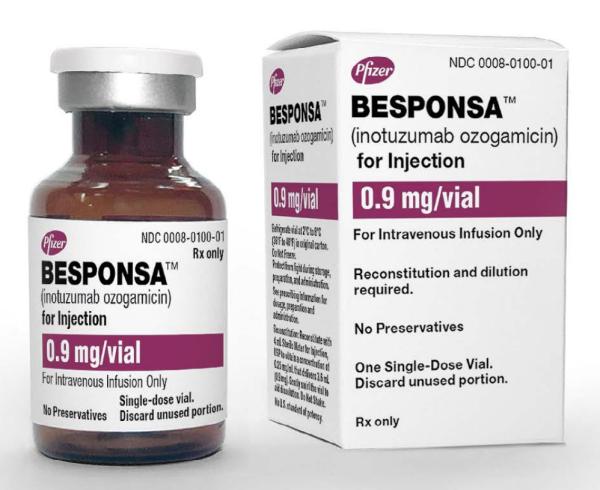Besponsa Side Effects
Generic name: inotuzumab ozogamicin
Note: This document provides detailed information about Besponsa Side Effects associated with inotuzumab ozogamicin. Some dosage forms listed on this page may not apply specifically to the brand name Besponsa.
Applies to inotuzumab ozogamicin: intravenous powder for solution.
Important warnings
This medicine can cause some serious health issues
Intravenous route (powder for solution)
Hepatotoxicity, including fatal and life-threatening VOD occurred in patients who received inotuzumab ozogamicin.A higher post-HSCT non-relapse mortality rate occurred in patients receiving inotuzumab ozogamicin.
Serious side effects of Besponsa
Along with its needed effects, inotuzumab ozogamicin (the active ingredient contained in Besponsa) may cause some unwanted effects. Although not all of these side effects may occur, if they do occur they may need medical attention.
Check with your doctor or nurse immediately if any of the following side effects occur while taking inotuzumab ozogamicin:
More common side effects
- black, tarry stools
- bleeding gums
- blood in the urine or stools
- chest pain
- chills
- cough or hoarseness
- coughing up blood
- difficulty in breathing or swallowing
- dizziness
- fever
- headache
- increased menstrual flow or vaginal bleeding
- lower back or side pain
- nosebleeds
- painful or difficult urination
- pale skin
- paralysis
- pinpoint red spots on the skin
- prolonged bleeding from cuts
- red or dark brown urine
- sore throat
- sores, ulcers, or white spots on the lips or in the mouth
- swollen glands
- troubled breathing with exertion
- unusual bleeding or bruising
- unusual tiredness or weakness
- yellow eyes or skin
Other side effects of Besponsa
Some side effects of inotuzumab ozogamicin may occur that usually do not need medical attention. These side effects may go away during treatment as your body adjusts to the medicine. Also, your health care professional may be able to tell you about ways to prevent or reduce some of these side effects.
Check with your health care professional if any of the following side effects continue or are bothersome or if you have any questions about them:
More common side effects
- constipation
- decreased appetite
- diarrhea
- nausea
- stomach pain
- swelling or inflammation of the mouth
- vomiting
For healthcare professionals
Applies to inotuzumab ozogamicin: intravenous powder for injection.
Hematologic adverse events
- Very common (10% or more): Thrombocytopenia (51%) (42% of which were Grade 3 or higher), neutropenia (49%) (48% of which were Grade 3 or higher), anemia (36%) (24% of which were Grade 3 or higher), leukopenia (35%) (33% of which were Grade 3 or higher), febrile neutropenia (26%) (all of which were Grade 3 or higher), lymphopenia (18%) (16% of which were Grade 3 of higher)
- Common (1% to 10%): Pancytopenia (e.g., bone marrow failure, febrile bone marrow aplasia, pancytopenia)[Ref]
Hypersensitivity
- Common (1% to 10%): Hypersensitivity[Ref]
Immunologic
- Very common (10% or more): Infection (48%) (28% of which were Grade 3 or higher)
- Frequency not reported: Immunogenicity[Ref]
Local
- Common (1% to 10%): Infusion related reaction[Ref]
Musculoskeletal
- Frequency not reported: Muscle hemorrhage[Ref]
Ocular
- Frequency not reported: Conjunctival hemorrhage, eyelid bleeding[Ref]
Metabolic
- Very common (10% or more): Decreased appetite (12%)
- Common (1% to 10%): Lipase increased, amylase increased, hyperuricemia
- Uncommon (0.1% to 1%): Tumor lysis syndrome[Ref]
Genitourinary
- Very common (10% or more): Vaginal hemorrhage (10%)
- Frequency not reported: Menorrhagia, hematuria[Ref]
Hepatic
- Very common (10% or more): Hyperbilirubinemia (21%), transaminases increased (26%), gamma-glutamyltransferase increased (21%), alkaline phosphatase increased (13%)[Ref]
Respiratory
- Frequency not reported: Epistaxis[Ref]
Other
- Very common (10% or more): Fatigue (35%), pyrexia (32%), chills (11%)
- Frequency not reported: Hemotympanum[Ref]
Nervous system
- Very common (10% or more): Headache (28%)[Ref]
Cardiovascular
- Very common (10% or more): Hemorrhage (33%) (5% of which were Grade 3 or higher)
- Common (1% to 10%): QT prolonged
- Frequency not reported: Intracranial hemorrhage, subdural hematoma[Ref]
Dermatologic
- Frequency not reported: Ecchymosis, hemorrhage subcutaneous, mesenteric hemorrhage, petechiae, post-procedural hematoma[Ref]
Gastrointestinal
- Very common (10% or more): Nausea (31%), abdominal pain (23%), diarrhea (17%), constipation (17%), vomiting (15%), stomatitis (13%)
- Common (1% to 10%): Abdominal distention, ascites
- Frequency not reported: GI hemorrhage, hemorrhagic gastritis, gingival bleeding, hematemesis, hematochezia, hemorrhoidal hemorrhage, intraabdominal hemorrhage, lip hemorrhage, upper/lower GI hemorrhage, mouth hemorrhage, oral mucosa hematoma, rectal hemorrhage[Ref]
References
1. (2017) "Product Information. Besponsa (inotuzumab ozogamicin)." Wyeth Laboratories
Frequently asked questions
More about Besponsa (inotuzumab ozogamicin)
- Check interactions
- Compare alternatives
- Pricing & coupons
- Drug images
- Dosage information
- During pregnancy
- FDA approval history
- Drug class: miscellaneous antineoplastics
- Breastfeeding
- En español
Patient resources
Professional resources
Related treatment guides
Further information
Besponsa side effects can vary depending on the individual. Always consult your healthcare provider to ensure the information displayed on this page applies to your personal circumstances.
Note: Medication side effects may be underreported. If you are experiencing side effects that are not listed, submit a report to the FDA by following this guide.

